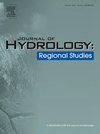A novel framework for automated water level estimation using CCTV imagery in Yongseong Agricultural Reservoir, South Korea
IF 5
2区 地球科学
Q1 WATER RESOURCES
引用次数: 0
Abstract
Study region
The study region is Yongseong Reservoir, located in Gyeongsangbuk-do, South Korea, a small agricultural reservoir primarily used for irrigation and is subject to pronounced hydrological seasonality.
Study focus
This study proposes a novel framework for estimating water levels in ungauged agricultural reservoirs using images from CCTVs originally installed for security purposes. The method integrates a U-Net-based water-body segmentation model with four machine learning regression algorithms (support vector regression, SVR; random forest, RF; extreme gradient boosting, XGB; and light gradient boosting machine, LGBM) to predict reservoir water levels from segmented water pixel counts. Importantly, we assess the potential of region of interest (ROI) filtering to enhance prediction accuracy, demonstrating that surveillance camera imagery can be effectively repurposed for hydrological monitoring in data-scarce environments.
New hydrological insights for the region
The results revealed that ROI filtering significantly improved prediction performance, increasing R² by 10–20 % and reducing root mean squared error by up to 0.197 (for RF). The RF model achieved the highest overall accuracy (R² = 0.964), while SVR performed best during no temporal variations. XGB and LGBM showed balanced residuals but slightly underestimated water levels during peak fluctuations. This study demonstrates the feasibility of image-based water-level estimation in ungauged agricultural reservoirs using security CCTVs. The results underscore the importance of spatial input refinement (ROI filtering) for reliable hydrological modeling.
韩国龙城农业水库闭路电视图像自动水位估计的新框架
研究区域研究区域是位于韩国庆尚北道的龙城水库,这是一个主要用于灌溉的小型农业水库,受明显的水文季节性影响。本研究提出了一个新的框架,利用最初为安全目的而安装的闭路电视的图像来估计未测量的农业水库的水位。该方法将基于u - net的水体分割模型与四种机器学习回归算法(支持向量回归,SVR;随机森林;极端梯度增强,XGB;和光梯度增强机(LGBM),从分割的水像素数预测水库水位。重要的是,我们评估了感兴趣区域(ROI)滤波的潜力,以提高预测精度,证明监控摄像机图像可以有效地重新用于数据稀缺环境中的水文监测。结果表明,ROI滤波显著提高了预测性能,将R²提高了10-20 %,并将均方根误差降低了0.197(对于RF)。RF模型的总体准确率最高(R²= 0.964),而SVR在无时间变化时表现最佳。XGB和LGBM表现出平衡的残差,但在峰值波动时略低估了水位。本研究论证了利用闭路电视在未计量的农业水库中进行基于图像的水位估算的可行性。结果强调了空间输入细化(ROI滤波)对于可靠的水文建模的重要性。
本文章由计算机程序翻译,如有差异,请以英文原文为准。
求助全文
约1分钟内获得全文
求助全文
来源期刊

Journal of Hydrology-Regional Studies
Earth and Planetary Sciences-Earth and Planetary Sciences (miscellaneous)
CiteScore
6.70
自引率
8.50%
发文量
284
审稿时长
60 days
期刊介绍:
Journal of Hydrology: Regional Studies publishes original research papers enhancing the science of hydrology and aiming at region-specific problems, past and future conditions, analysis, review and solutions. The journal particularly welcomes research papers that deliver new insights into region-specific hydrological processes and responses to changing conditions, as well as contributions that incorporate interdisciplinarity and translational science.
 求助内容:
求助内容: 应助结果提醒方式:
应助结果提醒方式:


